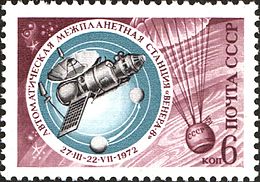Venera 8

Seal of Venera 8
|
|
| Mission type | Venus lander |
|---|---|
| Operator | Lavochkin |
| COSPAR ID | 1972-021A |
| SATCAT no. | 5912 |
| Mission duration | 117 days (travel) 50 minutes (lander) |
| Spacecraft properties | |
| Spacecraft | 4V-1 No.670 |
| Manufacturer | Lavochkin |
| Launch mass | 1,184 kilograms (2,610 lb) |
| Landing mass | 495 kilograms (1,091 lb) |
| Start of mission | |
| Launch date | 17 March 1972, 04:15:01 UTC |
| Rocket | Molniya-M/MVL |
| Launch site | Baikonur 31/6 |
| End of mission | |
| Last contact | 22 July 1972 |
| Orbital parameters | |
| Reference system | Geocentric |
| Semi-major axis | 6,591 kilometres (4,095 mi) |
| Eccentricity | 0.03732 |
| Perigee | 194 kilometres (121 mi) |
| Apogee | 246 kilometres (153 mi) |
| Inclination | 51.7° |
| Period | 88.9 minutes |
| Epoch | 17 March 1972 |
| Venus lander | |
| Landing date | 22 July 1972, 09:32 UTC |
| Landing site | 10°42′S 335°15′E / 10.70°S 335.25°E |
|
|
|
Venera 8 (Russian: Венера-8 meaning Venus 8) (manufacturer's designation: 3V (V-72)) was a probe in the Soviet Venera program for the exploration of Venus and was the first robotic space probe to conduct a successful landing on the surface of Venus.
Venera 8 was a Venus atmospheric probe and lander. Its instrumentation included temperature, pressure, and light sensors as well as an altimeter, gamma ray spectrometer, gas analyzer, and radio transmitters. The spacecraft took 117 days to reach Venus with one mid-course correction on 6 April 1972, separating from the bus (which contained a cosmic ray detector, solar wind detector, and ultraviolet spectrometer) and entering the atmosphere on 22 July 1972 at 08:37 UT. A refrigeration system attached to the bus was used to pre-chill the descent capsule's interior prior to atmospheric entry in order to prolong its life on the surface. Descent speed was reduced from 41,696 km/h to about 900 km/h by aerobraking. The 2.5 meter diameter parachute opened at an altitude of 60 km.
Venera 8 transmitted data during the descent. A sharp decrease in illumination was noted at 35 to 30 km altitude and wind speeds of less than 1 m/s were measured below 10 km. Venera 8 landed at 09:32 UT in what is now called Vasilisa Region, within 150 km radius of 10°42′S 335°15′E / 10.70°S 335.25°E, in sunlight, about 500 km from the morning terminator. The lander mass was 495 kg.
...
Wikipedia
